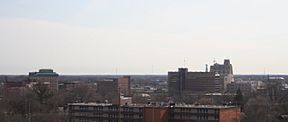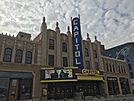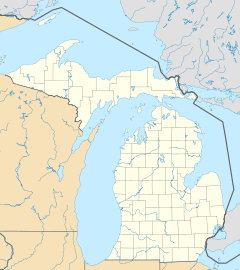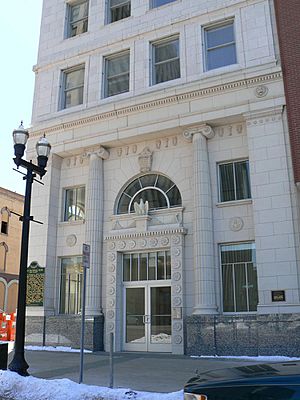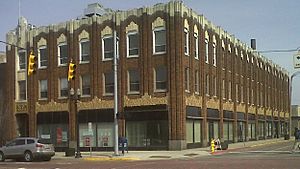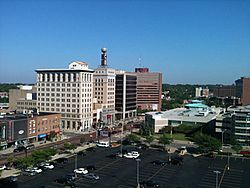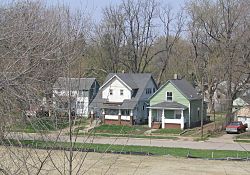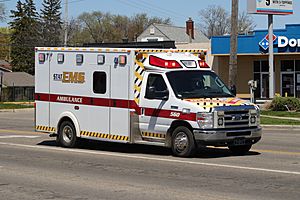Flint, Michigan facts for kids
Quick facts for kids
Flint, Michigan
|
|||
|---|---|---|---|
| City of Flint | |||
|
From top to bottom, left to right: Downtown skyline, Longway Planetarium, Capitol Theater, Flint Municipal Center, and the Paterson Building.
|
|||
|
|||
| Nicknames:
Vehicle City (official)
Flint Town (unofficial) |
|||
| Motto(s):
"Strong and Proud"
|
|||

Location within Genesee County
|
|||
| Country | United States of America | ||
| State | Michigan | ||
| County | Genesee | ||
| Settled | 1819 | ||
| Incorporated | 1855 | ||
| Government | |||
| • Type | Mayor–council | ||
| • Body | Flint City Council | ||
| Area | |||
| • City | 34.10 sq mi (88.33 km2) | ||
| • Land | 33.43 sq mi (86.59 km2) | ||
| • Water | 0.67 sq mi (1.74 km2) | ||
| Elevation | 751 ft (229 m) | ||
| Population
(2020)
|
|||
| • City | 81,252 | ||
| • Rank | US: 331st MI: 12th |
||
| • Density | 2,382.8/sq mi (919.87/km2) | ||
| • Urban | 356,218 (US: 106th) | ||
| • Metro | 406,892 (US: 134th) | ||
| Demonym(s) | Flintstone | ||
| Time zone | UTC−5 (EST) | ||
| • Summer (DST) | UTC−4 (EDT) | ||
| ZIP code(s) |
48501–48507, 48531, 48532, 48550–48557, 48559
|
||
| Area code(s) | 810 | ||
| FIPS code | 26-29000 | ||
| GNIS feature ID | 0626170 | ||
Flint is the largest city and seat of Genesee County, Michigan, United States. Located along the Flint River, 66 miles (106 km) northwest of Detroit, it is a principal city within the region known as Mid Michigan. At the 2020 census, Flint had a population of 81,252, making it the twelfth largest city in Michigan. The Flint metropolitan area is located entirely within Genesee County. It is the fourth largest metropolitan area in Michigan with a population of 406,892 in 2020. The city was incorporated in 1855.
Flint was founded as a village by fur trader Jacob Smith in 1819 and became a major lumbering area on the historic Saginaw Trail during the 19th century. From the late 19th century to the mid 20th century, the city was a leading manufacturer of carriages and later automobiles, earning it the nickname "Vehicle City". General Motors (GM) was founded in Flint in 1908, and the city grew into an automobile manufacturing powerhouse for GM's Buick and Chevrolet divisions, especially after World War II up until the early 1980s recession. Flint was also the home of a sit-down strike in 1936–37 that played a vital role in the formation of the United Auto Workers.
Since the late 1960s, Flint has faced several crises. The city experienced an economic downturn after GM significantly downsized its workforce in the area from a high of 80,000 in 1978 to under 8,000 by 2010. From 1960 to 2010, the population of the city nearly halved, from 196,940 to 102,434. In the mid-2000s, Flint became known for its comparatively high crime rates and has repeatedly been ranked among the most dangerous cities in the United States according to crime statistics. The city was under a state of financial emergency from 2002 to 2004 and again from 2011 to 2015.
From 2014 to 2019, Flint faced a public health emergency due to lead contamination in parts of the local water supply as well as an outbreak of Legionnaires' disease. The acute lead crisis has been addressed as the city has secured a new source of clean water, installed modern copper pipes to nearly every home, and distributed filters to all residents who want them. However, a legacy of distrust in public authorities remains.
Contents
- History
- Geography
- Demographics
- Sister cities
- Sports
- Education
- Infrastructure
- Notable people
- Images for kids
- See also
History
The Saginaw Valley, particularly the vicinity of Flint, is considered by some to be the oldest continually inhabited area of Michigan. Regardless of the validity of this claim, the region was home to several Ojibwa tribes at the start of the 19th century, with a particularly significant community established near present-day Montrose. The Flint River had several convenient fords which became points of contention among rival tribes, as attested by the presence of arrowheads and burial mounds near it.
19th century: lumber and the beginnings of the automobile industry
In 1819, Jacob Smith, a fur trader on cordial terms with both the local Ojibwas and the territorial government founded a trading post at the Grand Traverse of the Flint River. On several occasions, Smith negotiated land exchanges with the Ojibwas on behalf of the U.S. government, and he was highly regarded on both sides. Smith apportioned many of his holdings to his children. As the ideal stopover on the overland route between Detroit and Saginaw, Flint grew into a small but prosperous village, and incorporated in 1855. The 1860 U.S. census indicated that Genesee County had a population of 22,498 of Michigan's 750,000.
In the latter half of the 19th century, Flint became a center of the Michigan lumber industry. Revenue from lumber funded the establishment of a local carriage-making industry. As horse-drawn carriages gave way to the automobiles, Flint then naturally grew into a major player in the nascent auto industry. Buick Motor Company, after a rudimentary start in Detroit, soon moved to Flint. AC Spark Plug (now part of Delphi) originated in Flint. These were followed by several now-defunct automobile marques such as the Dort, Little, Flint, and Mason brands. And Chevrolet's first (and for many years, main) manufacturing facility was also in Flint, although the Chevrolet headquarters were in Detroit. For a brief period, all Chevrolets and Buicks were built in Flint.
Early and mid-20th century: the auto industry takes shape
In 1904, local entrepreneur William C. Durant was brought in to manage Buick, which became the largest manufacturer of automobiles by 1908. In 1908, Durant founded General Motors, filing incorporation papers in New Jersey, with headquarters in Flint. GM moved its headquarters to Detroit in the mid-1920s. Durant lost control of GM twice during his lifetime. On the first occasion, he befriended Louis Chevrolet and founded Chevrolet, which was a runaway success. He used the capital from this success to buy back share control. He later lost decisive control again, permanently. Durant experienced financial ruin in the stock market crash of 1929 and subsequently ran a bowling alley in Flint until the time of his death in 1947.
The city's mayors were targeted for recall twice, Mayor David Cuthbertson in 1924 and Mayor William H. McKeighan in 1927. Recall supporters in both cases were jailed by the police. Cuthbertson had angered the KKK by the appointment of a Catholic police chief. The KKK lead the recall effort and supported Judson Transue, Cutbertson's elected successor. Transue however did not remove the police chief. McKeighan survived his recall only to face conspiracy charges in 1928. McKeighan was under investigation for a multitude of crimes and ticked off the rest of the city leaders that they pushed for changes in the city charter.
In 1928, the city adopted a new city charter with a council-manager form of government. So, McKeighan ran the "Green Slate" of candidates who won in 1931 and 1932 and he was selected as mayor in 1931. In 1935, the city residents approved a charter amendment establishing the Civil Service Commission.
For the last century, Flint's history has been dominated by both the auto industry and car culture. During the Sit-Down Strike of 1936–1937, the fledgling United Automobile Workers triumphed over General Motors, inaugurating the era of labor unions. The successful mediation of the strike by Governor Frank Murphy, culminating in a one-page agreement recognizing the Union, began an era of successful organizing by the UAW. The city was a major contributor of tanks and other war machines during World War II due to its extensive manufacturing facilities. For decades, Flint remained politically significant as a major population center as well as for its importance to the automotive industry.
A freighter named after the city, the SS City of Flint was the first US ship to be captured during the Second World War in October, 1939. The vessel was later sunk in 1943.
'June 8, 1953 F5 Tornado'
The eighth deadliest tornado on record in the United States struck Beecher, just north of Flint, on June 8, 1953, killing 115 people, injuring 844. Known as the "Beecher Tornado", after the North Side community which the tornado devastated. On the next day the same weather system spawned the worst tornado in New England in Worcester, Massachusetts, killing another 94 people.
The city's population peaked in 1960 at almost 200,000, at which time it was the second largest city in the state. The decades of the 1950s and 1960s are seen as the height of Flint's prosperity and influence. They culminated with the establishment of many local institutions, most notably including the Flint Cultural Center. This landmark remains one of the city's chief commercial and artistic draws to this day.
Late 20th century: deindustrialization and demographic changes
Since the late 1960s through the end of the 20th century, Flint has suffered from disinvestment, deindustrialization, depopulation, urban decay, as well as high rates of crime, unemployment and poverty. Initially, this took the form of "white flight" that afflicted many urban industrialized American towns and cities. Given Flint's role in the automotive industry, this decline was exacerbated by the 1973 oil crisis and the U.S. auto industry's subsequent loss of market share to imports.
In the 1980s, the rate of deindustrialization accelerated again with local GM employment falling from a 1978 high of 80,000 to under 8,000 by 2010. Only 10% of the manufacturing work force from its height remains in Flint. Many factors have been blamed, including outsourcing, offshoring, increased automation, and moving jobs to non-union facilities.
This decline was highlighted in the film Roger & Me by Michael Moore (the title refers to Roger B. Smith, the CEO of General Motors during the 1980s). Also highlighted in Moore's documentary was the failure of city officials to reverse the trends with entertainment options (e.g. the now-demolished AutoWorld) during the 1980s. Moore, a native of Davison (a Flint suburb), revisited Flint in his later movies, including Bowling for Columbine and Fahrenheit 9/11.
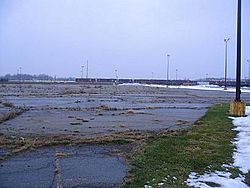
21st century
First financial emergency: 2002–2004
By 2002, Flint had accrued $30 million in debt.
On March 5, 2002, the city's voters recalled mayor Woodrow Stanley. A few months later, on May 8, the state of Michigan appointed an emergency financial manager, Ed Kurtz. The emergency financial manager displaced the temporary mayor, Darnell Earley, in the city administrator position.
In August, city voters elected former Mayor James Rutherford to finish the remainder of Stanley's term of office. On September 24, Kurtz commissioned a salary and wage study for top city officials from an outside accounting and consulting firm. The financial manager then installed a new code enforcement program for annual rental inspections and emergency demolitions. On October 8, Kurtz ordered cuts in pay for the mayor (from $107,000 to $24,000) and the City Council members (from $23,000 to $18,000). He also eliminated insurance benefits for most officials. After spending $245,000 fighting the takeover, the City Council ended the lawsuits on October 14. Immediately thereafter on October 16, a new interim financial plan was put in place by the manager. This plan initiated controls on hiring, overnight travel and spending by city employees. On November 12, Kurtz directed the city's retirement board to stop unusual pension benefits, which had decreased some retiree pensions by 3.5%. Kurtz sought the return of overpayments to the pension fund. However, in December, the state attorney general stated that Emergency Financial Managers do not have authority over the retirement system. With contract talks stalled, Kurtz stated that there either need to be cuts or layoffs to union employees. That same month, the city's recreation centers were temporarily closed.
Emergency measures continued in 2003. In May, Kurtz increased water and sewer bills by 11% and shut down operations of the ombudsman's office. In September 2003, a 4% pay cut was agreed to by the city's largest union. In October, Kurtz moved in favor of infrastructure improvements, authorizing $1 million in sewer and road projects. Don Willamson was elected a full-term mayor and sworn in on November 10. In December, city audits reported nearly $14 million in reductions in the city deficit. For the 2003–2004 budget year, estimates decreased that amount to between $6 million and $8 million.
With pressure from Kurtz for large layoffs and replacement of the board on February 17, 2004, the City Retirement Board agreed to four proposals reducing the amount of the city's contribution into the system. On March 24, Kurtz indicated that he would raise the City Council's and the Mayor's pay and in May, Kurtz laid off 10 workers as part of 35 job cuts for the 2004–05 budget. In June 2004, Kurtz reported that the financial emergency was over. Of the nearly 80,000 people that worked for General Motors in Flint during its peak years in the late 1970s, only about 8,000 were left after the most recent 2006 buyouts.
Redevelopment
In November 2013, American Cast Iron Pipe Company (ACIPCO), a Birmingham, Alabama based company, became the first to build a production facility in Flint's former Buick City site purchasing the property from the RACER Trust.
Commercially, local organizations have attempted to pool their resources in the central business district and to expand and bolster higher education at four local institutions. Examples of their efforts include the following:
- Landmarks such as the First National Bank building have been extensively renovated, often to create lofts or office space, and filming for the Will Ferrell movie Semi-Pro resulted in renovations to the Capitol Theatre.
- The Paterson Building at Saginaw and Third street has been owned by the Collison Family, Thomas W. Collison & Co., Inc., for the last 30 years. The building is rich in Art Deco throughout the interior and exterior. The building also houses its own garage in the lower level, providing heated valet parking to The Paterson Building Tenants.
- In 2004 the first planned residential community in Flint in over 30 years, University Park was built north of Fifth Avenue off Saginaw Street, Flint's main thoroughfare.
- Local foundations have also funded the renovation and redecoration of Saginaw Street, and have begun work turning University Avenue (formerly known as Third Avenue) into a mile-long "University Corridor" connecting University of Michigan–Flint with Kettering University.
- Atwood Stadium, located on University Avenue, has already received extensive renovations and the Cultivating Our Community project is landscaping 16 different locations from in Flint as a part of a $415,600 beautification project.
- Wade Trim and Rowe Incorporated have made major renovations to transform empty downtown Flint blocks into business, entertainment, and housing centers. WNEM, a local television station, has signed a ten-year lease on space in the Wade Trim building facing Saginaw Street.
- The long-vacant Durant Hotel, formerly owned by the United Hotels Company, was turned into a mixture of commercial space and apartments intended to attract young professionals or college students, with 93 units.
- In March 2008, the Crim Race Foundation put up an offer to buy the vacant Character Inn and turn it into a fitness center and do a multimillion-dollar renovation.
Similar to a plan in Detroit, Flint is in the process of tearing down thousands of abandoned homes in order to create available real estate. As of June 2009, approximately 1,100 homes have been demolished in Flint, with one official estimating another 3,000 more will have to be torn down.
Second financial emergency: 2011–present
On September 30, 2011, Michigan Governor Rick Snyder appointed an eight-member review team to review Flint's financial state with a request to report back in 30 days (half the legal time for a review). On November 8, 2011, Mayor Dayne Walling defeated challenger Darryl Buchanan 8,819 votes (56%) to 6,868 votes (44%). That same day, the Michigan State review panel declared the City of to be in the state of a "local government financial emergency" recommending the state again appoint an Emergency Manager. On November 14, the City Council voted 7 to 2 to not appeal the state review with Mayor Walling concurring the next day. Governor Snyder appointed Michael Brown as the city's Emergency Manager on November 29, effective December 1. On December 2, Brown dismissed a number of top administrators including City Administrator Gregory Eason, Human Resources Director Donna Poplar, Citizen Services Director Rhoda Woods, Green City Coordinator Steve Montle and independent officials including Ombudswoman Brenda Purifoy and Civil Service Commission Director Ed Parker. Pay and benefits from Flint's elected officials were automatically removed. On December 8, the office of Ombudsman and the Civil Service Commission were eliminated by Brown.
On January 16, 2012, protestors against the emergency manager law including Flint residents marched near the governor's home. The next day, Brown filed a financial and operating plan with the state as mandated by law. The next month, each ward in the city had a community engagement meeting hosted by Brown. Governor Sydner on March 7 made a statewide public safety message from Flint City Hall that included help for Flint with plans for reopening the Flint lockup and increasing state police patrols in Flint.
On March 20, 2012, days after a lawsuit was filed by labor union AFSCME, and a restraining order was issued against Brown, his appointment was found to be in violation of the Michigan Open Meetings Act and Mayor Walling and the City Council had their powers returned. The state immediately filed an emergency appeal, claiming the financial emergency still existed. On March 26, the appeal was granted, putting Brown back in power. Brown and several unions agreed to new contract terms in April. Brown unveiled his fiscal year 2013 budget on April 23. It included cuts in nearly every department including police and fire, as well as higher taxes. An Obsolete Property Rehabilitation District was created by Manager Brown in June 2012 for 11 downtown Flint properties. On July 19, the city pension system was transferred to the Municipal Employees Retirement System by the city's retirement board which led to a legal challenge.
On August 3, 2012, the Michigan Supreme Court ordered the state Board of Canvassers to certify a referendum on Public Act 4, the Emergency Manager Law, for the November ballot. Brown made several actions on August 7 including placing a $6 million public safety millage on the ballot and sold Genesee Towers to a development group for $1 to demolish the structure. The board certified the referendum petition on August 8, returning the previous Emergency Financial Manager Law into effect. With Brown previously temporary mayor for the last few years, Brown was ineligible to be the Emergency Financial Manager. Ed Kurtz was once again appointed Emergency Financial Manager by the Emergency Financial Assistance Loan Board.
Two lawsuits were filed in September 2012, one by the city council against Kurtz's appointment, while another was against the state in Ingham County Circuit Court claiming the old emergency financial manager law remains repealed. On November 30, the State Treasurer of Michigan Andy Dillon announced the financial emergency is still ongoing, and the emergency manager is still needed.
Michael Brown was re-appointed Emergency Manager on June 26, 2013, and returned to work on July 8. Flint had an $11.3 million projected deficit when Brown started as emergency manager in 2011. The city faces a $19.1 million combined deficit from 2012, with plans to borrow $12 million to cover part of it. Brown resigned from his position in early September 2013, and his last day was October 31. He was succeeded by Saginaw city manager (and former Flint temporary mayor) Darnell Earley.
Earley formed a blue ribbon committee on governance with 23 members on January 16, 2014 to review city operations and consider possible charter amendments. The blue ribbon committee recommends that the city move to a council-manager government. Six charter amendment proposals were placed on the November 4, 2014 ballot with the charter review commission proposal passing along with a reduction of mayoral staff appointments and budgetary best practices amendments. Proposals four through six, which would eliminate (4) requirement for certain executive departments, (5) the Civil Service Commission and (6) Ombudsman office were defeated. Flint elected a nine-member Charter Review Commission on May 5, 2015.
With Earley appointed to be emergency manager for Detroit Public Schools on January 13, 2015, city financial adviser Jerry Ambrose was selected to finish out the financial emergency with an expected exit in April. On April 30, 2015, the state moved the city from under from an emergency manager receivership to a Receivership Transition Advisory Board.
On November 3, 2015, Flint residents elected Karen Weaver as their first female mayor.
On January 22, 2016, the Receivership Transition Advisory Board unanimously voted to return some powers, including appointment authority, to the mayor.
Water state of emergency
In April 2014, Flint switched its water supply from Lake Huron (via Detroit) to the Flint River. The problem was compounded with the fact that anticorrosive measures were not implemented. After two independent studies, lead poisoning caused by the water was found in the area's population. This has led to several lawsuits, the resignation of several officials, thirteen criminal indictments, and a federal public health state of emergency for all of Genesee County.
Geography
Flint lies in the Flint/Tri-Cities region of Michigan. Flint and Genesee County can be categorized as a subregion of Flint/Tri-Cities. It is located along the Flint River, which flows through Lapeer, Genesee, and Saginaw counties and is 78.3 miles (126.0 km) long.
According to the United States Census Bureau, the city has a total area of 34.06 square miles (88.21 km2), of which, 33.42 square miles (86.56 km2) is land and 0.64 square miles (1.66 km2) is water. Flint lies just to the northeast of the Flint hills. The terrain is low and rolling along the south and east sides, and flatter to the northwest.
 |
Flushing, Mt. Pleasant, Traverse City | Saginaw, Bay City, Mackinaw City |  |
|
| Swartz Creek, Lansing, Grand Rapids | Davison, Lapeer, Port Huron | |||
| Kalamazoo, Benton Harbor, Chicago | Fenton, Ann Arbor, Toledo | Grand Blanc, Pontiac, Detroit |
Neighborhoods
Flint has several neighborhoods grouped around the center of the city on the four cardinal "sides". The downtown business district is centered on Saginaw Street south of the Flint River. Just west, on opposite sides of the river, are Carriage Town (north) and the Grand Traverse Street District (south). Both neighborhoods boast strong neighborhood associations. These neighborhoods were the center of manufacturing for and profits from the nation's carriage industry until the 1920s, and to this day are the site of many well-preserved Victorian homes and the setting of Atwood Stadium.
The University Avenue corridor of Carriage Town is home to the largest concentration of "Greek" housing in the area, with fraternity houses from both Kettering University, and the University of Michigan Flint. Chapter houses include Phi Delta Theta, Sigma Alpha Epsilon, Delta Chi, Theta Chi, Lambda Chi Alpha, Theta Xi, Alpha Phi Alpha, Phi Gamma Delta, and Delta Tau Delta Fraternities.
Just north of downtown is River Village, an example of gentrification via mixed-income public housing. To the east of I-475 is Central Park, a small neighborhood defined by culs-de-sac.
The North Side and 5th Ward are predominantly African American, with such historic districts as Buick City and Civic Park on the north, and Sugar Hill, Floral Park, and Kent and Elm Parks on the south. Many of these neighborhoods were the original centers of early Michigan blues. The South Side in particular was also a center for multi-racial migration from Missouri, Kentucky, Tennessee, and the Deep South since World War II. These neighborhoods are most often lower income, but have maintained some level of economic stratification. The East Side is the site of the Applewood Mott Estate, and Mott Community College, the Cultural Center, and East Village, one of Flint's more prosperous areas.
Just north is Eastside Proper, also known as the "State Streets", an area that has recently gentrified, and has much of Flint's Hispanic community. The West Side includes the main site of the 1936–37 sitdown strike, the Mott Park neighborhood, Kettering University, and the historic Woodcroft Estates, owned in the past by legendary automotive executives and current home to prominent and historic Flint families such as the Motts, the Manleys, and the Smiths.
Facilities associated with General Motors in the past and present are scattered throughout the city, including GM Truck and Bus, Flint Metal Center and Powertrain South (clustered together on the city's southwestern corner); Powertrain North, Flint Tool and Die and Delphi East. The largest plant, Buick City and adjacent facilities, have been demolished.
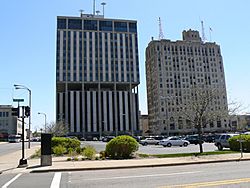
Half of Flint's fourteen tallest buildings were built during the 1920s. The 19-story Genesee Towers, formerly the city's tallest building, was completed in 1968. The building became unused in later years and fell into severe disrepair: a cautionary sign warning of falling debris was put on the sidewalk in front of it. An investment company purchased the building for $1, and it was demolished (by implosion) on December 22, 2013.
Climate
Typical of southeastern Michigan, Flint has a humid continental climate (Köppen Dfb), and is part of USDA Hardiness zone 6a. Winters are cold, with moderate snowfall and temperatures not rising above freezing on an average 52 days annually, while dropping to 0 °F (−18 °C) or below on an average 9.3 days a year; summers are warm to hot with temperatures exceeding 90 °F (32 °C) on 9.0 days. The monthly daily mean temperature ranges from 22.4 °F (−5.3 °C) in January to 70.5 °F (21.4 °C) in July. Official temperature extremes range from 108 °F (42 °C) on July 8 and 13, 1936 down to −25 °F (−32 °C) on January 18, 1976 and February 20, 2015; the record low maximum is −4 °F (−20 °C) on January 18, 1994, while, conversely the record high minimum is 79 °F (26 °C) on July 18, 1942. Decades may pass between readings of 100 °F (38 °C) or higher, which last occurred July 17, 2012. The average window for freezing temperatures is October 8 thru May 7, allowing a growing season of 153 days. On June 8, 1953, Flint was hit by an F5 tornado, which claimed 116 lives.
Precipitation is moderate and somewhat evenly-distributed throughout the year, although the warmer months average more, averaging 31.4 inches (800 mm) annually, but historically ranging from 18.08 in (459 mm) in 1963 to 45.38 in (1,153 mm) in 1975. Snowfall, which typically falls in measurable amounts between November 12 through April 9 (occasionally in October and very rarely in May), averages 42.5 inches (108 cm) per season, although historically ranging from 16.0 in (41 cm) in 1944–45 to 83.9 in (213 cm) in 2013–14. A snow depth of 1 in (2.5 cm) or more occurs on an average 64 days, with 53 days from December to February.
| Climate data for Flint, Michigan (Bishop Int'l), 1981–2010 normals, extremes 1921–present | |||||||||||||
|---|---|---|---|---|---|---|---|---|---|---|---|---|---|
| Month | Jan | Feb | Mar | Apr | May | Jun | Jul | Aug | Sep | Oct | Nov | Dec | Year |
| Record high °F (°C) | 65 (18) |
68 (20) |
86 (30) |
88 (31) |
93 (34) |
104 (40) |
108 (42) |
103 (39) |
100 (38) |
89 (32) |
79 (26) |
70 (21) |
108 (42) |
| Mean maximum °F (°C) | 49.7 (9.8) |
52.0 (11.1) |
68.6 (20.3) |
79.0 (26.1) |
84.5 (29.2) |
91.2 (32.9) |
92.2 (33.4) |
91.3 (32.9) |
86.8 (30.4) |
77.9 (25.5) |
66.5 (19.2) |
53.1 (11.7) |
94.1 (34.5) |
| Average high °F (°C) | 29.6 (−1.3) |
32.8 (0.4) |
43.5 (6.4) |
57.3 (14.1) |
68.5 (20.3) |
77.9 (25.5) |
81.9 (27.7) |
79.7 (26.5) |
72.3 (22.4) |
59.6 (15.3) |
46.7 (8.2) |
34.1 (1.2) |
57.1 (13.9) |
| Average low °F (°C) | 15.3 (−9.3) |
16.9 (−8.4) |
24.8 (−4.0) |
35.5 (1.9) |
45.3 (7.4) |
55.2 (12.9) |
59.2 (15.1) |
57.9 (14.4) |
49.9 (9.9) |
39.4 (4.1) |
31.0 (−0.6) |
20.8 (−6.2) |
37.7 (3.2) |
| Mean minimum °F (°C) | −6.2 (−21.2) |
−2.9 (−19.4) |
5.6 (−14.7) |
20.9 (−6.2) |
31.4 (−0.3) |
40.7 (4.8) |
46.3 (7.9) |
44.9 (7.2) |
34.5 (1.4) |
25.5 (−3.6) |
16.4 (−8.7) |
1.1 (−17.2) |
−9.7 (−23.2) |
| Record low °F (°C) | −25 (−32) |
−25 (−32) |
−16 (−27) |
6 (−14) |
22 (−6) |
33 (1) |
40 (4) |
37 (3) |
26 (−3) |
19 (−7) |
−7 (−22) |
−13 (−25) |
−25 (−32) |
| Average precipitation inches (mm) | 1.63 (41) |
1.48 (38) |
1.91 (49) |
2.89 (73) |
3.08 (78) |
3.07 (78) |
3.32 (84) |
3.18 (81) |
3.75 (95) |
2.47 (63) |
2.67 (68) |
1.92 (49) |
31.37 (797) |
| Average snowfall inches (cm) | 13.1 (33) |
10.8 (27) |
6.5 (17) |
2.3 (5.8) |
trace | 0 (0) |
0 (0) |
0 (0) |
0 (0) |
0.4 (1.0) |
2.5 (6.4) |
11.8 (30) |
47.4 (120) |
| Average precipitation days (≥ 0.01 in) | 13.6 | 10.5 | 11.3 | 12.6 | 11.1 | 10.6 | 9.5 | 10.0 | 10.0 | 10.8 | 11.8 | 13.9 | 135.7 |
| Average snowy days (≥ 0.1 in) | 12.8 | 9.9 | 6.2 | 2.3 | 0 | 0 | 0 | 0 | 0 | 0.3 | 3.1 | 10.4 | 45.0 |
| Average relative humidity (%) | 75.3 | 73.1 | 70.3 | 65.8 | 65.5 | 68.4 | 69.6 | 73.3 | 75.6 | 73.2 | 75.6 | 77.4 | 71.9 |
| Source: NOAA (relative humidity 1961–1990) | |||||||||||||
Demographics
| Historical population | |||
|---|---|---|---|
| Census | Pop. | %± | |
| 1850 | 1,670 | — | |
| 1860 | 2,950 | 76.6% | |
| 1870 | 5,386 | 82.6% | |
| 1880 | 8,409 | 56.1% | |
| 1890 | 9,803 | 16.6% | |
| 1900 | 13,103 | 33.7% | |
| 1910 | 38,550 | 194.2% | |
| 1920 | 91,599 | 137.6% | |
| 1930 | 156,492 | 70.8% | |
| 1940 | 151,543 | −3.2% | |
| 1950 | 163,143 | 7.7% | |
| 1960 | 196,940 | 20.7% | |
| 1970 | 193,317 | −1.8% | |
| 1980 | 159,611 | −17.4% | |
| 1990 | 140,761 | −11.8% | |
| 2000 | 124,943 | −11.2% | |
| 2010 | 102,434 | −18.0% | |
| 2020 | 81,252 | −20.7% | |
| U.S. Decennial Census 2010-2020 |
|||
2020 census
| Race / Ethnicity | Pop 2010 | Pop 2020 | % 2010 | % 2020 |
|---|---|---|---|---|
| White alone (NH) | 36,537 | 26,372 | 35.67% | 32.46% |
| Black or African American alone (NH) | 57,451 | 45,293 | 56.09% | 55.74% |
| Native American or Alaska Native alone (NH) | 455 | 302 | 0.44% | 0.37% |
| Asian alone (NH) | 450 | 404 | 0.44% | 0.50% |
| Pacific Islander alone (NH) | 14 | 25 | 0.01% | 0.03% |
| Some Other Race alone (NH) | 140 | 424 | 0.14% | 0.52% |
| Mixed Race/Multi-Racial (NH) | 3,411 | 4,476 | 3.33% | 5.51% |
| Hispanic or Latino (any race) | 3,976 | 3,956 | 3.88% | 4.87% |
| Total | 102,434 | 81,252 | 100.00% | 100.00% |
Note: the US Census treats Hispanic/Latino as an ethnic category. This table excludes Latinos from the racial categories and assigns them to a separate category. Hispanics/Latinos can be of any race.
2010 Census
As of the census of 2010, there were 102,434 people, 40,472 households, and 23,949 families residing in the city. The population density was 3,065.1 inhabitants per square mile (1,183.4/km2). There were 51,321 housing units at an average density of 1,535.6 per square mile (592.9/km2). The racial makeup of the city was 56.6% African American, 37.4% White, 0.5% Native American, 0.5% Asian, 1.1% from other races, and 3.9% from two or more races. Hispanic or Latino of any race were 3.9% of the population. Non-Hispanic Whites were 35.7% of the population in 2010, compared to 70.1% in 1970.
There were 40,472 households, of which 34.3% had children under the age of 18 living with them, 23.1% were married couples living together, 29.0% had a female householder with no husband present, 7.1% had a male householder with no wife present, and 40.8% were non-families. 33.9% of all households were made up of individuals, and 9.8% had someone living alone who was 65 years of age or older. The average household size was 2.45 and the average family size was 3.13.
The median age in the city was 33.6 years. 27.3% of residents were under the age of 18; 11.3% were between the ages of 18 and 24; 25.5% were from 25 to 44; 25.1% were from 45 to 64; and 10.7% were 65 years of age or older. The gender makeup of the city was 48.0% male and 52.0% female.
In 2016, Niraj Warikoo of the Detroit Free Press stated that area community leaders stated that the Hispanic and Latino people made up close to 6% of the city population, while the city also had 142 Arab-American families. According to the most recent data from the U.S. Census Bureau, slightly over 1% of Flint's population was born outside the U.S., and over three-quarters of that foreign-born population have become naturalized citizens.
Sister cities
 Changchun, Jilin, China
Changchun, Jilin, China Faislabad, Pakistan
Faislabad, Pakistan Hamilton, Ontario, Canada
Hamilton, Ontario, Canada Kielce, Świętokrzyskie Voivodeship, Poland
Kielce, Świętokrzyskie Voivodeship, Poland Tolyatti, Samara Oblast, Russia
Tolyatti, Samara Oblast, Russia
Sports
| Club | Sport | League | Venue |
| Flint City Bucks | Soccer | USL League 2 | Atwood Stadium |
| Flint Rogues Rugby Club | Rugby | Michigan Rugby Football Union | Longway Park |
| Flint Fury | Football | Midwest Elite Football Alliance | Flint Hamady High School |
| Flint United | Men's Basketball | The Basketball League | Dort Financial Center |
| Flint Monarchs | Women's basketball | Women's American Basketball | Dort Financial Center |
| Flint Firebirds | Hockey | Ontario Hockey League | Dort Financial Center |
| Flint City Handball Club | Club Team Handball | TBD | Berston Fieldhouse |
American football
There is semi-pro football at Atwood Stadium with the Flint Fury. Atwood is an 11,000+ seat stadium in downtown Flint which has hosted many events, including baseball. When artificial turf was installed, it was no longer able to host baseball games. The Flint Fury have been in action since 2003, and are currently a part of the Great Lakes Football League. The team was founded by two of its players; Charles Lawler and Prince Goodson, who both played for the defunct Flint Falcons semi-pro team. The team is now solely owned by Lawler.
The 2009 Heisman Trophy winner Mark Ingram, born and raised in Grand Blanc, attended his final year of high school at Flint Southwestern Academy. He won the Heisman with 1304 total votes. Ingram attended the University of Alabama and is their first Heisman winner. He was a member of the National Champion 2009 Alabama Crimson Tide football team.
Basketball
Many Flint natives have played basketball in the National Basketball Association (NBA), NCAA Division 1 or European professional basketball. NBA champion Glen Rice, Eddie Robinson and three-time NBA champion JaVale McGee, and Washington Wizards forward Kyle Kuzma all hail from Flint, as do Morris Peterson, Mateen Cleaves, and Charlie Bell (four of the five starters from Michigan State University's "Flintstones" 2000 National Championship team).
Local teacher and independent film maker Marcus Davenport chronicles Flint's ties to basketball and the basketball culture in his documentary Flint Star: The Motion Picture. Will Ferrell's 2008 movie Semi-Pro is based on the fictional basketball team the "Flint Tropics".
Ice hockey
On January 14, 2015, the Ontario Hockey League's Plymouth Whalers were relocated to Flint after a sale of the team to the owner of Perani Arena for the 2015–16 season. The team changed its name to the Flint Firebirds.
Other sports
Flint is twinned with Hamilton, Ontario, and its amateur athletes compete in the CANUSA Games, held alternatively there and here since 1957.
Former sports teams
| Club | Sport | League | Venue |
| Flint Flames (2000) | Arena football | Indoor Football League | IMA Sports Arena |
| Michigan Pirates (2007) | Arena Football | Continental Indoor Football League | Perani Arena and Event Center |
| Flint Phantoms (2008) | Arena Football | Continental Indoor Football League | Perani Arena and Event Center |
| Flint Flyers (1889–1891) | Baseball | Michigan State League | Venue Unknown |
| Flint Vehicles (1906–1915, 1921–1925) | Baseball | Michigan-Ontario League | Athletic Park |
| Flint Halligans (1919–1920) | Baseball | Michigan-Ontario League | Athletic Park |
| Flint Gems (1940) | Baseball | Michigan State League | Atwood Stadium |
| Flint Indians (1941) | Baseball | Michigan State League | Atwood Stadium |
| Flint Arrows (1948–1951) | Baseball | Central League | Atwood Stadium |
| Flint Pros (1972–1974) | Basketball | Continental Basketball Association | IMA Auditorium |
| Flint Fuze (2001) | Basketball | Continental Basketball Association | IMA Sports Arena |
| UM-Flint Kodiaks | College Football | National Club Football Association | Atwood Stadium |
| Flint Wildcats (1974–1977) | Football | Midwest Football League | Atwood Stadium |
| Flint Sabres (1974–1988) | Football | Midwest Football League | Atwood Stadium |
| Flint Falcons (1992–2001) | Football | Michigan Football League, Ohio Valley Football League | Atwood Stadium, Holy Redeemer Field |
| Michigan Admirals (2002–2009) | Football | North American Football League, United States Football Alliance | Hamady Field, Russ Reynolds Field, Atwood Stadium |
| Genesee County Patriots (2003–2009) | Football | Ohio Valley Football League, North American Football League | Atwood Stadium, Guy V. Houston Stadium |
| Flint Blue Devils | Football | League unknown | Atwood Stadium |
| Flint Yellow Jackets | Football | League unknown | Atwood Stadium |
| Flint Rampage | Football | Great Lakes Football League | Atwood Stadium |
| Flint Generals (1969–1985) | Hockey | International Hockey League | IMA Center |
| Flint Spirits (1985–1990) | Hockey | International Hockey League | IMA Sports Arena |
| Flint Bulldogs (1991–1993) | Hockey | Colonial Hockey League | IMA Sports Arena |
| Flint Generals (1993–2010) | Hockey | Colonial/United/International Hockey League (1993–2010) | Perani Arena and Event Center |
| Michigan Warriors (2010–2015) | Hockey | North American Hockey League | Perani Arena, Iceland Arena |
| Flint City Riveters | Women's Football | Women's Football Alliance | Guy V. Houston Stadium |
| Michigan Phoenix | Women's Soccer | Women's Premier Soccer League | Guy V. Houston Stadium |
| Waza Flo | indoor soccer | Major Arena Soccer League | Dort Federal Credit Union Event Center |
Education
Colleges and universities
- University of Michigan–Flint
- Kettering University
- Mott Community College
- Michigan State University College of Human Medicine
- Baker College
Primary and secondary schools
Public K-12 education is provided under the umbrella of the Flint Community Schools. Students attend ten elementary schools, one middle school, and one high school (Flint Southwestern Academy). The city's original high school, Flint Central High School, was closed in 2009 because of a budget deficit and a lack of maintenance on the building by the Flint School District. The building, however, still stands. Flint Northern High School was converted to an alternative education school at the start of the 2013–14 school year and was closed later in 2014. The state-run Michigan School for the Deaf is located in Flint, and Michigan School for the Blind was previously there, having moved from Lansing in 1995.
The Catholic high school is Fr. Luke M. Powers Catholic High School which is part of the Roman Catholic Diocese of Lansing and serves the entire county. The school moved from its location just north of Flint in Mt. Morris Township in 2013 into the former Michigan School for the Deaf building off of Miller Road in Flint, which received a $22 million renovation. The Valley School is a small private K–12 school. Flint also has several charter schools.
Libraries
The Flint Public Library holds 454,645 books, 22,355 audio materials, 9,453 video materials, and 2,496 serial subscriptions.
Infrastructure
Bus lines
The city of Flint is served by various bus lines. For travel within and around the city, the Flint Mass Transportation Authority (MTA) provides local bus services. Indian Trails provides inter-city bus service north to Saint Ignace, through Bay City and south to Pontiac, Southfield and Detroit, and runs services west to Chicago. MTA's main hub is in Downtown Flint, while the Indian Trails station is co-located at the Flint Amtrak station on Dort Highway, just north of I-69.
Major highways
 I-69 runs east and west through Flint.
I-69 runs east and west through Flint.
 I-75 / US 23 runs north and south through the southwestern part of the city near the General Motors Flint Assembly complex and Bishop International Airport.
I-75 / US 23 runs north and south through the southwestern part of the city near the General Motors Flint Assembly complex and Bishop International Airport. I-475 runs north and south through Flint.
I-475 runs north and south through Flint. M-21 (also known as Corunna Road and Court Street) runs nearly due east and west through Flint, west of I-475
M-21 (also known as Corunna Road and Court Street) runs nearly due east and west through Flint, west of I-475 M-54, also known as Dort Highway after Flint automotive pioneer Josiah Dallas Dort, runs north and south through the eastern part of the city.
M-54, also known as Dort Highway after Flint automotive pioneer Josiah Dallas Dort, runs north and south through the eastern part of the city.
Railroads
Amtrak provides intercity passenger rail service on the Blue Water line from Chicago to Port Huron at the border to Canada. The Amtrak station is located on Dort Highway, just north of I-69. The station was built in 1989 and replaced an earlier Grand Trunk Western Railroad (GTW) station closer to downtown. Canadian National Railway (GTW's successor) and Lake State Railway provide freight service to Flint, with CN operating from Bristol Yard on the western side of the city and LSRC operating from the former CSX Transportation McGrew Yard to the north. While CSX ceded control of their former Saginaw Subdivision north of Plymouth to LSRC in 2019, they continue to operate trackage rights trains over CN from Flint to Port Huron several times per week as of 2020. Into the late 1940s, the Pere Marquette Railway operated daily passenger trains through a separate station 1 1/4 miles away, with trains heading north to Saginaw and Bay City and south to Detroit's Fort Street Union Depot.
Airports
Flint is served by three passenger and two cargo airlines at Bishop International Airport. It is located on Bristol Road between I-75 and I-69. Dalton Airport, a public use airport near Flushing, also serves small, privately owned planes. Price's Airport in Linden serves the same purpose.
Healthcare
- Hurley Medical Center
- McLaren Regional Medical Center
- Flint once had two other full service hospitals: St. Joseph's Hospital and Flint Osteopathic Hospital (FOH). In 1988, HealthSource Group, the parent company of FOH, became affiliated with St. Joseph Health Systems. In 1992, St. Joseph Health Systems changed its name to Genesys Health System and the names of its four hospitals to Genesys Regional Medical Center (GRMC). On February 15, 1997, all the former GHS hospitals were consolidated into one hospital at Genesys Regional Medical Center at Health Park in suburban Grand Blanc Township (now owned by Ascension Health who later changed its name to Ascension Genesys Hospital) and Flint Osteopathic Hospital was razed during the Spring/Summer of 2015.
Notable people
Images for kids
-
A railroad bridge in Flint re-painted to show the name of rock band Grand Funk Railroad, which was formed in the city in 1969.
See also
 In Spanish: Flint (Míchigan) para niños
In Spanish: Flint (Míchigan) para niños


